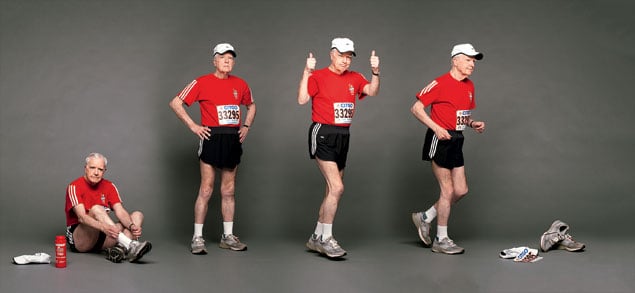Running is supposed to be metaphorical–your life in motion, hurtling toward challenge, overcoming pain and disappointment, maybe winning a race. I started for different reasons. Most doctors won’t say so, but many men face a “male menopause.” I certainly did. At age 55, I took up running–my way of holding onto tenuous fitness and disappearing youth.
Living in Michigan at the time, I timidly entered a 10K race. I knew women ran slightly slower than men, so I devised a strategy: catch a woman, pass her, then catch another and pass her till I was ahead. My plan lasted for two women. Later, panting around Tiger Stadium in another 10K, I swore that if I finished I’d never run anything longer. Within a year, I had run the Detroit-Windsor marathon with blood-soaked socks.
After moving to Washington in 1988, I completed the Marine Corps Marathon five times, then began entering races in Europe, where I eventually ran in virtually every capital. My wife met me every six miles with power bars, juice, and encouragement.
In Paris, we started on the Champs Élysées, ran to the Place de la Concorde, then passed the Louvre, the Joan of Arc statue, the Place de la Bastille, and the Bois de Boulogne, over streets where tumbrils once rolled, carriages clattered, and Hemingway walked.
In a brasserie the night before, I ordered decaf in my best restaurant French. The waiter misheard and brought Turkish espresso, which kept me awake all night. I ran the race without sleep, muttering something like “Quel dommage,” the closest I can come to my actual words in a family magazine.
In Bordeaux, the marathon is really a Mardi Gras, with most participants in costumes: nuns, cows, convicts racing from chateau to chateau. At water stops, the French serve wine, play music, and seem to feel everyone should drink and dance before continuing.
Pasta parties on the eve of marathons are traditional for carbo-loading. In Moscow, beer is served and eight-year-old folk dancers twirl. At the time, I was a classical-music announcer on Washington’s WGMS, so when I returned to my show I described the Moskva River at daybreak, Mussorgsky playing in the background: “It’s first light on the Moskva, reflections flickering blue and white on the bridge above. St. Basil’s Cathedral broods nearby, onion domes awaiting full daylight.”
My best racing time was Berlin in 1996, a fast course that runs through the Brandenburg Gate into the former East Germany–a strange feeling when you’ve lived through World War II and the Cold War. Berlin has always been a city of contrasts: nightmarish, partitioned, courageous.
In honor of my 70th birthday in 2000, I ran the JFK 50 Mile ultramarathon. It starts in Boonsboro, Maryland, and, following a horseshoe-shaped route, ends in nearby Williamsport–a little like running from Reagan National Airport to Purcellville, Virginia. I was lucky to lose only one toenail.
Now I’ve run 36 marathons in North America, Europe, Australia, and Asia. Last April I turned 80, and in May I did the Ottawa Marathon, winning my age group–I was the only one in it–and becoming a Canadian Masters Marathon Champion. I’ve enjoyed running with a fast crowd, but these days I’m a speed walker and gym rat. When people ask why anyone my age would run, I used to say, “Mountain climbers climb mountains because they’re there. Marathoners run marathons because they’re not all there.” The real answer is that, after 25 years, I’ve changed my mind: With all its injuries, setbacks, and ultimate triumphs, running really is a metaphor for life.
Williamson Day lives in Potomac Falls.
This article appears in the April 2012 issue of The Washingtonian.


















